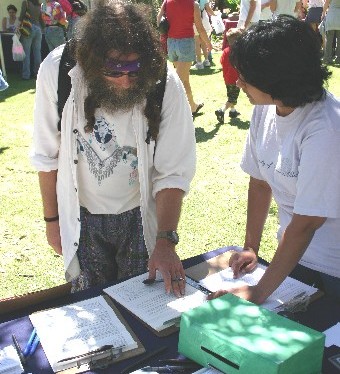Recruitment and leadership development are critical to the strength and success of your organization. While small groups may be easy to work with, there’s a limit to the progress you can make by working with a small group of folks. And no matter how large your group may be, if you’re not developing new leaders you’re not going to be very successful – because sooner or later (presumably) you’ll graduate – and the group will be back at square one. On the other hand, by investing in the future of your organization you’re setting yourself up for success – the larger and more empowered your group is, the more likely you are to win.
Some major motivators can include: Generally, one of the best ways to recruit new members is by running an exciting and dynamic campaign that draws people into your group. Large numbers of students will learn about your group and write their names on your sign-up sheets if you hold rallies, teach-ins, sponsor speakers, petition, and regularly table. Whenever your group organizes a notable activity (petition, rally, educational forum), always send out press releases to both campus and off-campus media. With a little work, your organization will receive substantial media coverage, especially in smaller papers that are always looking for stories. Media coverage builds your organization’s credibility and helps you recruit. Finally, build alliances with other progressive organizations (both student and community ones) by participating in their campaigns and events, and getting them to likewise participate in yours. By being visible, you can collect a large list of people who support your group and its goals. - top - The kick-off meeting is the first big event your group will organize during the semester. Make it count! The goal is to recruit new members and get new students involved with the group. Try to make sure that the meeting is fun, interesting, and participatory. The first step is to take care of logistics. Pick a time when the most people can come. Don’t panic! There’s no perfect time when everyone can make it. Try to pick a time and place that can stay the same each week. Set a goal for how many people you want at your meeting (be ambitious). Then reserve a room that you think will be a little too small. When you pack a room it creates an atmosphere of excitement; there’s nothing worse than empty chairs at a kick off meeting. Try to find a room with movable chairs so you can sit in a circle. The meeting should be planned far enough in advance to wallpaper the school with flyers and send an announcement to all available campus media. Furthermore, the agenda should be planned out to the minute and the meeting should be well facilitated. Kick-off meetings are a great time to bring in a guest speaker - often a well-liked progressive professor will bring more people to an event as well as keeping it interesting. If it’s possible, get food for your meeting. Food’s always nice, and it will help keep everyone in a good mood. Another mood-saver is to start and end roughly on time. You want to convince people that the group is a good use of their time.
During this first meeting, it’s important for everyone to give introductions, which works best with a fun icebreaker. Don’t have all the “core people” sit together in a block during meetings; instead, disperse yourselves throughout the group. This creates a mood that’s much more participatory. Pass around a sheet to collect everybody’s name, phone number and email. One of the planners should give a brief introduction to the group. New groups need to emphasize that a group is what people make it. If the planners have some ideas, they should be presented, but as well-developed suggestions, not declarations. This should take only about 5 minutes. Every attendee should leave the first meeting with a good understanding of what the group's purpose is, how they can fit into the group, and with confidence that the group is action-oriented. The organizers should ensure that every new member leaves with a specific assignment or task to work on before the next meeting. Work assignments not only make new people feel like vital and needed members of the group, but people are also more likely to return for future meetings when they feel that they have a responsibility to the group. Of course, you want to encourage individuals to willingly take on tasks rather than just autocratically assigning jobs to new people – dude, that’s just not cool. Some key things to do at the first meeting: ..........• Establish Working
Groups on key projects (e.g., further recruitment, fundraising,
media stunt, campaign development, etc.) Make your first meeting fun - provide food, play a game - but make sure that it is much more than a social event. Afterwards, have everyone go to a café or bar to keep talking and facilitate a chance for people to get to know each other. A lot of good potential activists will come back because of someone they met the first night who they would like to see again (for romantic or platonic reasons!). Remember, organizing is about building relationships. - top -
- top - ..........• Not taking recruitment
seriously; not treating it like a campaign complete with goals,
strategy, etc. - top - A good place to start is where support is likely to be strongest - for example, the membership (and leadership) of other progressive groups, or your classmates in courses that address issues like poverty, labor history, racial justice, or environmental activism. Many professors will allow you to take a few minutes of class time to make announcements if you ask beforehand. In addition to focusing on likely allies, you should also take advantage of the many "new student" events or student activities' fairs frequently held at the beginning of the school year to reach out to the wider school population. Remember that one of the keys to building organizations and movements is attracting new supporters and reaching out to non-traditional allies. Students are busy and have a lot of demands on their time. You have to compel them to pay attention - and some techniques are more effective than others. The more human and personal the interaction, the better chance you have that someone will join your organization and help build your campaign effort - and that you’ll win. Some techniques that you can use include: You’ll want to use many of these; keep in mind that it often takes a combination of several methods to convince someone to come to a rally or meeting. - top - Using the four C’s is one of the best ways of recruiting new people into your organization:
Examples: “So you can table Thursday outside of the campus center at lunch? I’ll call you Wednesday night to remind you the place and time. Thanks so much!” “So you can make it to the meeting? How about I give you a call the night before to remind you?” “So you wanna set up a meeting w/ the president to talk about Bhopal? How about I check-in w/ you in two days to see how it’s coming?” Common pitfalls: Never forget the rule of halves. If you get 100 people to say they will do something, only 50 will actually follow through. - top - "To table" means to set up a table in a central location,
sit there or stand in front of it, and try to entice people to come,
look over your information, and hear what you have to say. Tabling
can be used as a petition-signing or letter-writing station, as
a tool to educate and recruit students unfamiliar with the group
or campaign, or as a means to collect donations. It doesn't require
a large number of volunteers, Say what? Some helpful tips to remember when tabling include: ..........• There will probably
be other tables around, and you’ll be competing with other
groups for people’s attention. You’ll need to be active
- stand in front of your table – don’t slouch behind
it. Clipboard in hand, go up to people and get them to sign a petition
or give them a handout. - top - Canvassing means going door to door, either on campus or in your community (depending on your campaign and its goals) and pitching a campaign, passing out literature, offering a petition, raising money, or all of the above. Canvassing is one of the most fun, active tactics you can use. It will bring a lot of volunteers into your group, but it can also turn some shy people off. Remember that it’s essential that whoever is leading the volunteers is very friendly and enthusiastic about canvassing. Dorm canvassing is a great tool, if used properly, to both recruit and retain volunteers. It gives new volunteers or those bored with tabling or passing out flyers the opportunity to have fun with a larger group of enthusiastic people. And it gives those volunteers, properly trained and armed with a clipboard and good informational material, the opportunity to personally reach out to many new people and establish a basis for further contact. Remember, also, to have other tactics available for volunteers who are shy about talking to strangers. In order to successfully canvass your school, your group should have a specific plan, set goals, and train and motivate all involved volunteers. Every canvasser should be courteous and respectful of others’ privacy, and they should have a concise, informative, and upbeat canvassing rap prepared (i.e., a brief descriptive speech about Bhopal stressing what you want the listener to do – sign a petition, come to an event, etc.). They should also be receptive to questions and suggestions. ..........• Gather together a
large group of canvassers. With about 10 or 20 people you can cover
a large area and have fun. - top - From the first person who volunteers to help you hand out flyers, to the dozens or hundreds that may come to your protest, your group should be vigilant in contacting and activating every single student who indicates a desire to join the group or work for the campaign. If you do not use the volunteers you have, you will lose them and will not recruit any new ones. Have regular meetings at a regular location and regular time, each with a specific pre-planned agenda that ensures that at every meeting something solid is decided and some action is organized. Your group should always be in the process of researching, planning, carrying out, or wrapping up some campaign or event. You cannot recruit people to an inactive organization, and you cannot make a difference just by talking about it. When you see a new face at a meeting or event, make sure that person is immediately incorporated into whatever is happening. Talk to the new person as soon as you can and introduce her/him to the other people that are there. Make every effort to ensure that new volunteers feel welcomed and have a go-around of introductions at the start of every meeting. And don’t forget a sign-up sheet! Call new volunteers within 24 to 48 hours. If people want more information, get it to them within a similar time frame. Avoid the tendency to be become too dependent on e-mail for outreach. While email is an excellent way to maintain communication between already active group members, it’s overused used as an initial outreach tool. The effectiveness of a personal phone call to a potential new supporter can’t be overstated. Once you have a small group of enthusiastic and empowered supporters, you can more effectively recruit others. - top - The beginning of the school year is a good time to spend a Saturday or Sunday discussing the group’s vision and creating a strategic plan for the year. Set aside a large chunk of time (like six hours). Choose issues, assign responsibility for tasks and create a timeline. By being strategic and building internal community, your organization will achieve far more than most other clubs. At different times during the year, you might want to organize training sessions to increase the skill level of your members. Your group specialists should spend an hour teaching everyone else how they write press releases, speak in front of crowds, handle your administrative bureaucracy, facilitate meetings, make sense of the group’s campaign, etc. Encourage new people to take on positions of responsibility. - top - ..........• Campaign is making
progress - top - It’s important to develop new leaders within your organization
– and to do so with everything that you do. Always keep your
eyes peeled for new opportunities to share responsibility and create
leadership opportunities. A few tips: - top -
Aquene explains:
|
The international student campaign to hold Dow
accountable for Bhopal, and its other toxic legacies around the world.
For more information about the campaign, or for problems regarding this
website, contact Ryan
Bodanyi, the Coordinator of Students for Bhopal.
WE
ALL LIVE  IN
BHOPAL
IN
BHOPAL
"The year 2003 was a special year in the history of the campaign for justice in Bhopal. It was the year when student and youth supporters from at least 30 campuses in the US and India took action against Dow Chemical or in support of the demands of the Bhopal survivors. As we enter the 20th year of the unfolding Bhopal disaster, we can, with your support, convey to Dow Chemical that the fight for justice in Bhopal is getting stronger and will continue till justice is done. We look forward to your continued support and good wishes, and hope that our joint struggle will pave the way for a just world free of the abuse of corporate power."
Signed/ Rasheeda Bi, Champa Devi Shukla
Bhopal Gas Affected Women Stationery Employees Union
International Campaign for Justice in Bhopal
This is what the www.studentsforbhopal.org site looked like in early 2008. For more recent information, please visit www.bhopal.net.







 Recruitment
should be a top priority at all times
Recruitment
should be a top priority at all times but
as an ongoing activity it can use many volunteers. It’s a
great way to involve new volunteers and members – it’s
easy enough for anyone to pull off and they'll get excited about
the group and learn a lot in the process.
but
as an ongoing activity it can use many volunteers. It’s a
great way to involve new volunteers and members – it’s
easy enough for anyone to pull off and they'll get excited about
the group and learn a lot in the process.